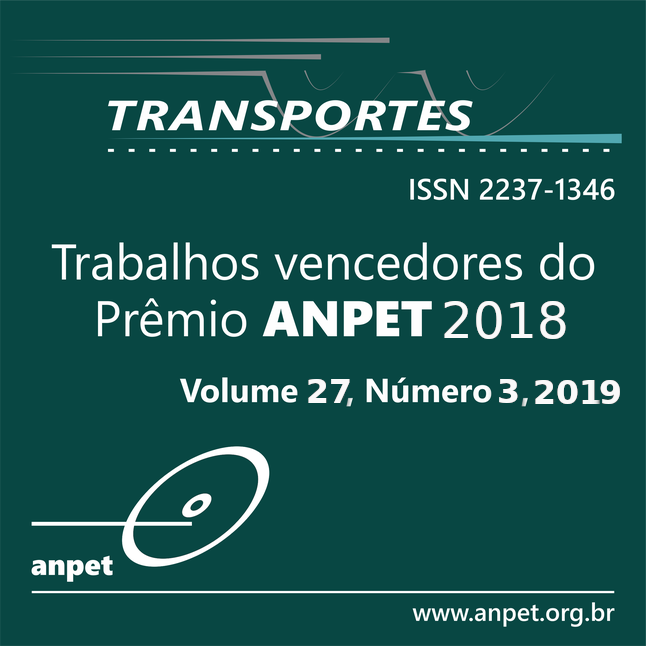Ambiente construído e bem-estar subjetivo: análise das diferenças entre os usuários dos diferentes modos de transporte
DOI:
https://doi.org/10.14295/transportes.v27i3.2021Palavras-chave:
Caminhabilidade, Modelos de equações estruturais, Segurança pública, Percepção do bairro, Satisfação com o bairro.Resumo
O bem-estar subjetivo (subjective well-being) tem sido foco de crescente atenção na comunidade acadêmica nas últimas décadas, e especificamente na área de transportes (economia, ambiente urbano, mobilidade e acessibilidade). Os objetivos desse estudo são analisar a existência de diferenças na percepção do ambiente construído entre usuários de transporte ativo, transporte coletivo e transporte individual; e comparar o efeito do ambiente construído no bem-estar para os três grupos de usuários. Utilizando dados de uma pesquisa de atividade física na cidade de São Paulo - Brasil, modelos de equações estruturais multigrupo foram estimados. O estudo mostrou que o ambiente construído influencia o bem-estar dos indivíduos para os três grupos de usuários. Evidenciou a existência de diferenças na percepção do ambiente construído entre os grupos. Os resultados podem contribuir para debates acadêmicos e políticos sobre bem-estar, qualidade de vida e sustentabilidade urbana considerando a falta de investigações empíricas aprofundadas sobre este tópico.
Downloads
Referências
Basarić V.; A. Vujičić; J. M. Simić; V. Bogdanović e N. Saulić (2016) Gender and Age Differences in the Travel Behavior – A Novi Sad Case Study. Transportation Research Procedia, v. 14, p. 4324-4333. DOI: 10.1016/j.trpro.2016.05.354.
Brown, G. T.; L. R. Harris; C. O'Quin e K. E. Lane (2015) Using multi-group confirmatory factor analysis to evaluate cross-cultural research: identifying and understanding non-invariance. International Journal of Research & Method in Education. v. 40, n. 1, p. 66-90. DOI: 10.1080/1743727X.2015.1070823.
Cabrera, J. F. (2013). New urbanism and selection bias in the formation of social capital. Housing Policy Debate, v. 23, n. 2, p. 376–394. DOI: 10.1080/10511482.2013.766626.
Cheung, G.W. e R. B. Rensvold (2002) Evaluating goodness-of-fit indexes for testing measurement invariance. Structural equation modeling, v. 9, n. 2, p. 233-255. DOI: 10.1207/S15328007SEM0902_5.
Delbosc, A. (2012) The role of well-being in transport policy. Transp. Policy, v. 23, p. 25–33. DOI: 10.1016/j.tranpol.2012.06.005.
Diamantopoulos, A.; P. Riefler e K. P. Roth (2008) Advancing formative measurement models. Journal of Business Research, v. 61, n. 12, p. 1203-1218. DOI: 10.1016/j.jbusres.2008.01.009.
Diener, E. (1984) Subjective Well-Being. Psychological Bulletin, v. 95, p. 542-575. DOI:10.1037/0033-2909.95.3.542.
Diener, E. (1994) Assessing subjective wellbeing: progress and opportunities. Social Indicators Research, v. 31, p. 103-157. DOI: 10.1007/BF01207052.
Dong, H. e Qin, B. (2017) Exploring the link between neighborhood environment and mental wellbeing: A case study in Beijing, China. Landscape and Urban Planning, v. 164, p. 71-80. DOI: 10.1016/j.landurbplan.2017.04.005.
Elias, W.; J. Benjamin e Y. Shiftan (2015) Gender differences in activity and travel behavior in the Arab world. Transport Policy, v. 44, p. 19-27. ISSN 0967-070X. DOI: 10.1016/j.tranpol.2015.07.001.
Gehl, J. (2013) Cities for people. Island press. ISBN 9781597265737
González, R. M.; E. Martínez-Budría; J. J. Díaz-Hernández e A. Esquivel (2015) Explanatory factors of distorted perceptions of travel time in tram. Transportation Research Part F: Traffic Psychology and Behaviour, v. 30, p. 107-114. ISSN 1369-8478. DOI: 10.1016/j.trf.2015.02.006.
Grasser, G.; S. Titze e W. J. Stronegger (2016) Are residents of high-walkable areas satisfied with their neighbourhood? Journal of Public Health, v. 24, n. 6, p. 469-476. DOI: 10.1007/s10389-016-0744-5.
Hair, J. F.; W. C. Black; B. J. Babin; R. E. Anderson e R. L. Tatham (2009) Análise Multivariada de Dados. 6 ed. Bookman. Porto Alegre. ISBN 857780402X
Heizomi, H.; H. Allahverdipour; M. A. Jafarabadi e A. Safaian (2015) Happiness and its relation to psychological well-being of adolescents. Asian Journal of Psychiatry, v. 16, p. 55-60. DOI:10.1016/j.ajp.2015.05.03.
Her, Y. W.; H. Shin e S. Pae (2018) A multigroup SEM analysis of moderating role of task uncertainty on budgetary participation-performance relationship: Evidence from Korea. Asia Pacific Management Review. DOI: 10.1016/j.apmrv.2018.02.001.
Hipp, J. R. e A. J. Perrin (2009) The simultaneous effect of social distance and physical distance on the formation of neighborhood ties. City & Community, v. 8, n. 1, p. 5-25. DOI: 10.1111/j.1540-6040.2009.01267.x.
Hu, L. (2017) Changing travel behavior of Asian immigrants in the U.S. Transportation Research Part A: Policy and Practice, v. 106, p. 248-260. ISSN 0965-8564. DOI: 10.1016/j.tra.2017.09.019.
Jacobs J. (2011) Morte e vida de grandes cidades. 2. ed. [s.l.] WMF Martins Fontes. ISBN 9788578274214
Joshanloo, M. (2017) Mediators of the relationship between externality of happiness and subjective well-being. Personality and Individual Differences, v. 119, p. 147-151. DOI: 10.1016/j.paid.2017.07.017.
Kim, H. e R. Millsap (2014) Using the Bollen-Stine Bootstrapping Method for Evaluating Approximate Fit Indices. NIH Public Access, v. 49, n. 6, p. 161–169. DOI: 10.1080/00273171.2014.947352.
Kim, S.; S. Park e J. S. Lee (2014) Meso-or micro-scale? Environmental factors influencing pedestrian satisfaction. Transportation Research Part D: Transport and Environment, v. 30, p. 10-20, 2014. DOI: 10.1016/j.trd.2014.05.005.
Larranaga, A. M. e H. B. B. Cybis (2014) The relationship between built environment and walking for different trip purposes in Porto Alegre, Brazil. Int Journal of Sustainable Development and Planning, v. 9, n. 4, p. 568-580. DOI: 10.2495/SDP-V9-N4-568-580.
Larranaga, A. M.; J. L. D. Ribeiro e H. B. B. Cybis (2009) Fatores que afetam as decisões individuais de realizar viagens a pé: estudo qualitativo. Transportes, v. 17, n. 2. DOI: 10.14295/transportes.v17i2.355.
Larranaga, A. M.; L. I. Rizzi; J. Arellana; O. Strambi e H. B. B. Cybis (2014) The Influence of built environment and travel attitudes on walking: a case study of Porto Alegre, Brazil. International Journal of Sustainable Transportation, v. 10, n. 4, p. 332-342. DOI: 10.1080/15568318.2014.933986.
Lee, S. M.; T. L. Conway; L. D. Frank; B. E. Saelens; K. L. Cain e J. F. Sallis (2017) The relation of perceived and objective environment attributes to neighborhood satisfaction. Environm and Behaviour, v. 49, n. 2, p. 136-160. DOI: https://doi.org/10.1016/j.tbs.2018.02.005.
Leslie, E. e E. Cerin (2008) Are perceptions of the local environment related to neighbourhood satisfaction and mental health in adults?. Preventive Medicine, v. 47, n. 3, p. 273-278. DOI: 10.1016/j.ypmed.2008.01.014.
Leyden, K. M. (2003) Social capital and the built environment: the importance of walkable neighborhoods. American Journal of Public Health, v. 93, n. 9, p. 1546-1551. DOI: 10.2105/AJPH.93.9.1546.
Limbers, C. A.; D. A. Newman e J. W. Varni (2009) Factorial Invariance of Child Self-Report Across Race/Ethnicity Groups: A Multigroup Confirmatory Factor Analysis Approach Utilizing the PedsQL™ 4.0 Generic Core Scales. Annals of Epidemiology, v. 19, n. 8, p. 575-581. DOI: 10.1016/j.annepidem.2009.04.004.
Lin, T.; D. Wang e X. Guan (2017) The built environment, travel attitude, and travel behavior: Residential self-selection or residential determination?. Journal of Transport Geography, v. 65, p. 111-122. ISSN 0966-6923. DOI: 10.1016/j.jtrangeo.2017.10.004.
Lucchesi, S. T; A. M. Larranaga e H. B. B. Cybis (2018) Does Walkability Raise Real Estate Values in Brazil? A Hedonic Model Approach on Rio de Janeiro City. Transportation Research Board 97th Annual Meeting. 2018 Jan 7-11; Washington DC, United States.
Lucchesi, S. T. (2016) Aplicação de preços hedônicos para avaliação da influência da caminhabilidade no preço dos imóveis. Dissertação de Mestrado – PPGEP, UFRGS. Disponível em http://hdl.handle.net/10183/150501. (Acesso em 5 agosto 2019).
Mccrea, R.; R. Stimson e J. Western (2005) Testing a moderated model of satisfaction with urban living using data for Brisbane-South East Queensland, Australia. Social Indicators Research, v. 72, n. 2, p. 121-152. DOI: 10.1007/s11205-004-2211-x.
Mouratidis, K. (2018) Built environment and social well-being: How does urban form affect social life and personal relationships?. Cities, v. 74, p. 7-20. DOI: 10.1016/j.cities.2017.10.020.
Musa, H. D.; M. R. Yacob; A. M. Abdullah e M. Y. Ishak (2018) Enhancing subjective well-being through strategic urban planning: Development and application of community happiness index. Sustainable Cities and Society, v. 38, p. 184-194. DOI: 10.1016/j.scs.2017.12.030.
Reardon, L. e Abdallah, S. (2013) Well-being and transport: taking stock and looking forward. Transport Rev, v. 33, n. 6, p. 634–657. DOI: 10.1080/01441647.2013.837117.
Samios, A. A. B. (2018) Impacto do ambiente construído na utilização de modos ativos: análise das percepções dos usuários de diferentes modos de transporte. Dissertação de Mestrado – PPGEP, UFRGS. Disponível em: http://hdl.handle.net/10183/179524. (Acesso em 3 setembro 2019).
Schumacker, R. E. e R. G. Lomax (2010) A beginner's guide to structural equation modeling. Psychology press.
Singleton, P. A. (2018) Walking (and cycling) to well-being: Modal and other determinants of subjective well-being during the commute. Travel Behaviour and Society (in press). DOI:10.1016/j.tbs.2018.02.005.
Sirgy, M. J. e T. Cornwell (2002). How neighborhood features affect quality of life. Social Indicators Research, v. 59, n. 1, p. 79-114. DOI: 10.1023/A:1016021108513.
Spinney, J. E. L.; D. M. Scott e K. B. Newbold (2009) Transport mobility benefits and quality of life: a time-use perspective of elderly Canadians. Transport Policy, v. 16, n. 1, p. 1–11. DOI:10.1016/j.tranpol.2009.01.002.
Stanley, J. e J. Stanley (2007) Public transport and social policy goals. Road and Transport Res, v. 16, p. 20-30. ISSN 1037-5783
Stanley, J. e D. Vella-Brodrick (2009) The usefulness of social exclusion to inform social policy in transport. Transport Policy, v. 16, p. 106-114. DOI: 10.1016/j.tranpol.2009.02.003.
Stanley, J.; D. A. Henscher; J. Stanley; G. Currie; W.H. Greene e D. Vella-Brodrick (2011) Social exclusion and the value of mobility. Journal of Transport Economics and Policy, v. 45, p. 197-222.
Van Dyck, D.; G. Cardon; B. Deforche e I. D. Bourdeaudhuij (2011) Do adults like living in high-walkable neighborhoods? Associations of walkability parameters with neighborhood satisfaction and possible mediators. Health & Place, v. 17, n. 4, p. 971-977. DOI: 10.1016/j.healthplace.2011.04.001.
Vargas, J. C. B.; A. M. L. Uriarte e H.B.B. Cybis (2016) Explorando as viagens a pé: estrutura urbana e sensação de segurança. Anais do XXX Congresso de Pesquisa e Ensino em Transportes, ANPET.
Wang, D. e X. Cao (2017) Impacts of the built environment on activity-travel behavior: Are there differences between public and private housing residents in Hong Kong? Transportation Research Part A: Policy and Practice, v. 103, p. 25-35. DOI:10.1016/j.tra.2017.05.018.
Wood, L.; L. D. Frank e B. Giles-Corti (2010) Sense of community and its relationship with walking and neighborhood design. Social Science & Medicine, v. 70, n.9, p. 1381–1390. DOI:10.1016/j.socscimed.2010.01.021.
Yang, S.; Y. Fan; W. Deng e L. Cheng (2017) Do built environment effects on travel behavior differ between household members? A case study of Nanjing, China. Transport Policy. ISSN 0967-070X. DOI: 10.1016/j.tranpol.2017.12.006.
Ziersch, A. M.; F. E. Baum; C. MacDougall e C. Putland (2005) Neighbourhood life and social capital: The implications for health. Social Science & Medicine, v. 60, n. 1, p. 71–86. DOI: 10.1016/j.socscimed.2004.04.027.
Downloads
Publicado
Como Citar
Edição
Seção
Licença
Ao submeter um manuscrito para publicação neste periódico, todos os seus autores concordam, antecipada e irrestritamente, com os seguintes termos:
- Os autores mantém os direitos autorais e concedem à Transportes o direito de primeira publicação do manuscrito, sem nenhum ônus financeiro, e abrem mão de qualquer outra remuneração pela sua publicação pela ANPET.
- Ao ser publicado pela Transportes, o manuscrito fica automaticamente licenciado sob a Licença Creative Commons CC BY 4.0. Esta licença permite o seu compartilhamento com reconhecimento da autoria e da publicação inicial neste periódico.
- Os autores têm autorização para assumir contratos adicionais separadamente, para distribuição não exclusiva da versão do trabalho publicada neste periódico (por ex.: publicar em repositório institucional ou como capítulo de livro), com reconhecimento da publicação inicial na Transportes, desde que tal contrato não implique num endosso do conteúdo do manuscrito ou do novo veículo pela ANPET.
- Os autores têm permissão e são estimulados a publicar e distribuir seu manuscrito online (por ex.: em repositórios institucionais ou na sua página pessoal) depois de concluído o processo editorial. Como a Transportes é de acesso livre, os autores são estimulados a usar links para o DOI do artigo nesses casos.
- Os autores garantem ter obtido a devida autorização dos seus empregadores para a transferência dos direitos nos termos deste acordo, caso esses empregadores possuam algum direito autoral sobre o manuscrito. Além disso, os autores assumem toda e qualquer responsabilidade sobre possíveis infrações ao direito autoral desses empregadores, isentando a ANPET e a Transportes de toda e qualquer responsabilidade neste sentido.
- Os autores assumem toda responsabilidade sobre o conteúdo do manuscrito, incluindo as devidas e necessárias autorizações para divulgação de dados coletados e resultados obtidos, isentando a ANPET e a Transportes de toda e qualquer responsabilidade neste sentido.









